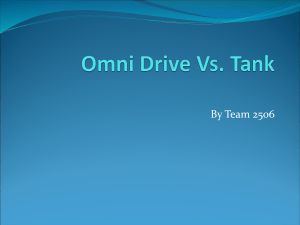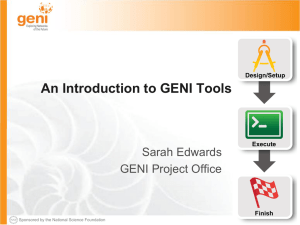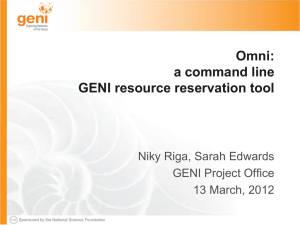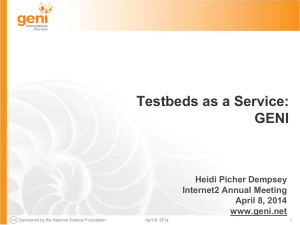- GENI Wiki
advertisement
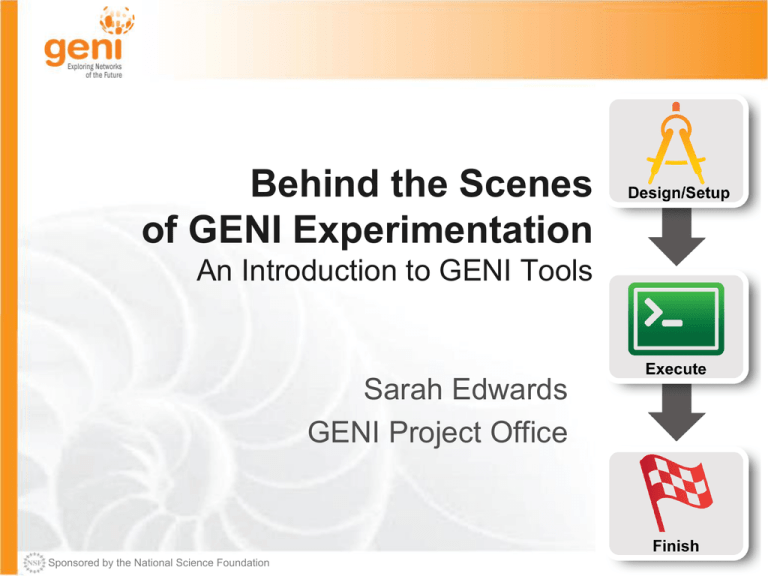
Behind the Scenes of GENI Experimentation An Introduction to GENI Tools Sarah Edwards GENI Project Office Sponsored by the National Science Foundation Outline GENI Tools: Behind the scenes Other GENI resource reservation tools Omni, jFed, Flack, Portal GENI support for automating resource reservation Custom images, install and execute scripts Instrumentation and Measurement Tools GENI Desktop and LabWiki Sponsored by the National Science Foundation Train-the-TA – January 30, 2015 2 In Part 1 You Learned… • To run a simple experiment – Logging into the Portal – Using a tool such as Jacks (or jFed) to reserve resources – Logging into resources – Manually installing software in resources jFed • Control interface vs. data interfaces Jacks Sponsored by the National Science Foundation Train-the-TA – January 30, 2015 3 In Part 2 You will Learn… • What happens behind the scenes when you run an experiment on GENI • New concepts: – GENI Resource Specifications (RSpecs) – GENI Aggregate Manager API (GENI AM API) Sponsored by the National Science Foundation Train-the-TA – January 30, 2015 4 GENI Resource Specifications (RSpecs) • RSpecs are XML documents that describe resources – VMs, links, etc. RSpec for a virtual machine with one interface: <?xml version="1.0" encoding="UTF-8"?> <rspec type="request” xsi:schemaLocation="http://www.geni.net/resources/rspec/3 … xmlns="http://www.geni.net/resources/rspec/3"> <node client_id="server" component_manager_id="urn:publicid:IDN+instageni.gpolab.bbn.com+auth ority+cm”> <sliver_type name="emulab-openvz"/> <interface client_id="server:if0”> </interface> </node> </rspec> Sponsored by the National Science Foundation Train-the-TA – January 30, 2015 5 RSpecs • RSpec documents are exchanged by experimenter tools (e.g. Jacks) and aggregates – Aggregates use RSpecs to describe what they have – Advertisement RSpecs – Experimenters use RSpecs to describe the resources they want – Request RSpecs – Aggregates use RSpecs to describe the resources allocated to an experimenter – Manifest RSpecs Sponsored by the National Science Foundation Train-the-TA – January 30, 2015 6 The GENI AM API • Experimenter tools and aggregates talk to each other using the GENI Aggregate Manager API (GENI AM API) What do you have? Experimenter Tool I would like … ListResources(…) Advertisement RSpec CreateSliver(Request RSpec, …) What do I have? Manifest RSpec ListResources(SliceName, …) Manifest RSpec Sponsored by the National Science Foundation I have … Train-the-TA – January 30, 2015 You have Aggregate … Manager You have … 7 Putting it all Together… • When you drag and drop resources on to the Jacks/jFed canvas, a request RSpecs for these resources is created I would like … – To view the request RSpec… jFed • When you click Add Resources/Run, createSliver is called on the aggregates Jacks Sponsored by the National Science Foundation Train-the-TA – January 30, 2015 8 Putting it all Together… • Tool periodically calls sliverStatus on the aggregates to check on the status of your request • When sliverStatus shows: jFed – Resources are ready to use, when they turn green Jacks Sponsored by the National Science Foundation Train-the-TA – January 30, 2015 9 What do I have? Putting it all Together… • ListResources with a slice name returns a manifest RSpec You have … • Manifest includes names and ports used to ssh into VMs jFed – Tool uses this information to help you log into your resources Sponsored by the National Science Foundation Train-the-TA – January 30, 2015 10 Putting it all Together… • When you delete resources, tool calls deleteSliver on aggregates Sponsored by the National Science Foundation Train-the-TA – January 30, 2015 11 Outline GENI Tools: Behind the scenes Other GENI resource reservation tools Omni, jFed, Flack, Portal GENI support for automating resource reservation Custom images, install and execute scripts Instrumentation and Measurement Tools GENI Desktop and LabWiki Sponsored by the National Science Foundation Train-the-TA – January 30, 2015 12 GENI Resource Reservation Tools All GENI resource reservation tools speak the AM API and RSpec… Jacks/Portal Hosted Flack omni Local $ omni createsliver aliceslice myRSpec.xml INFO:omni: ----------------------------------INFO:omni: Completed createsliver: jFed Options as run: aggregate: https://www.emulab. framework: pgeni native: True Args: createsliver aliceslice myRSpec.xml Result Summary: Slice urn:publicid:IDN+pgeni Reserved resources on https://www.emulab.net/p Saved createsliver results to aliceslice-man INFO:omni: =================================== Next we’ll explore a command line tool … Sponsored by the National Science Foundation Train-the-TA – January 30, 2015 13 Omni: Resource Reservation tool • A command line experimenter tool • Useful for making AM API calls on aggregates • Written in and scriptable from Python • Works with aggregates that implement the GENI AM API – InstaGENI and ExoGENI racks, ProtoGENI, PlanetLab, FOAM (OpenFlow AM) $ omni.py createsliver aliceslice myRSpec.xml INFO:omni:Loading config file omni_config INFO:omni:Using control framework pgeni INFO:omni:Slice urn:publicid:IDN+pgeni.gpolab. expires within 1 day on 2011-07-07 INFO:omni:Creating sliver(s) from rspec file INFO:omni:Writing result of createsliver for INFO:omni:Writing to ‘aliceslice-manifest-rspe INFO:omni: ----------------------------------INFO:omni: Completed createsliver: Options as run: aggregate: https://www.emulab. framework: pgeni native: True Args: createsliver aliceslice myRSpec.xml Result Summary: Slice urn:publicid:IDN+pgeni Reserved resources on https://www.emulab.net/p Saved createsliver results to aliceslice-man INFO:omni: =================================== http://trac.gpolab.bbn.com/gcf/wiki/Omni Sponsored by the National Science Foundation Train-the-TA – January 30, 2015 14 Omni Command Workflow Create Slice Create Sliver Cleanup Repeat for each aggregate Repeat for each aggregate createslice getversion deletesliver renewslice listresources listmyslices createsliver sliverstatus Legend: AM API command Sponsored by the National Science Foundation Train-the-TA – January 30, 2015 15 Sample Omni Commands omni –a aggregatename listresources omni –a aggregatename createsliver slicename requestRSpec omni –a aggregatename sliverstatus slicename omni –a aggregatename listresources slicename omni –a aggregatename deletesliver slicename • A useful utility (distributed with Omni): readyToLogin –a aggregatename slicename – Gives you the ssh commands you need to log into your nodes • readyToLogin parses the output of listresources and sliverstatus to determine the hostname, port and username for the ssh commands Sponsored by the National Science Foundation Train-the-TA – January 30, 2015 16 CONFIGURE OMNI Sponsored by the National Science Foundation Train-the-TA – January 30, 2015 17 Configuring Omni • Omni reads a configuration file omni_config to: – Find locations of ssl certs and ssh key files • ssl certs are used to secure communication between Omni and the aggregates • ssh key pairs are used log into compute resources – Find standard nicknames for aggregates • e.g. you can refer to the InstaGENI rack at NYSERNet as nysernet-ig instead of https://instageni.nysernet.org:12369/protogeni/xmlrpc/am Sponsored by the National Science Foundation Train-the-TA – January 30, 2015 18 Creating an Omni Config File 1. Download the GENI bundle from the GENI Portal 2. Run omni-configure in a terminal window $ omni-configure Sponsored by the National Science Foundation Train-the-TA – January 30, 2015 19 Omni Hands-On 1. Find Login information readyToLogin –a aggregatename slicename 2. Create a new reservation omni –a aggregatename createsliver slicename requestRSpec Sponsored by the National Science Foundation Train-the-TA – January 30, 2015 20 Outline GENI Tools: Behind the scenes Other GENI resource reservation tools Omni, jFed, Flack, Portal GENI support for automating resource reservation Custom images, install and execute scripts Instrumentation and Measurement Tools GENI Desktop and LabWiki Sponsored by the National Science Foundation Train-the-TA – January 30, 2015 21 Custom Images Custom Images • Standard images are available • Snapshot standard images to create custom images Sponsored by the National Science Foundation Train-the-TA – January 30, 2015 22 Install/Execute Scripts Install scripts • Place a tarball (.tgz file) on a publicly accessible webserver • Specify the url and a destination (e.g. /tmp) in your RSpec • Specify the name of a command or a script to run at resource reservation time • The file at the url is downloaded, decompressed and placed in the specified destination Sponsored by the National Science Foundation Train-the-TA – January 30, 2015 23 Outline GENI Tools: Behind the scenes Other GENI resource reservation tools Omni, jFed, Flack, Portal GENI support for automating resource reservation Custom images, install and execute scripts Instrumentation and Measurement Tools GENI Desktop and LabWiki Sponsored by the National Science Foundation Train-the-TA – January 30, 2015 24 GENI Desktop Sponsored by the National Science Foundation Train-the-TA – January 30, 2015 25 Conclusions Tips • Select tools that work best for what you are doing • Automation of experiments is really important In General…. – – – – Start small Change one thing at a time Automate as you go Then scale up Sponsored by the National Science Foundation Train-the-TA – January 30, 2015 26
